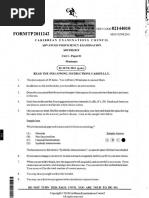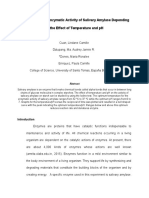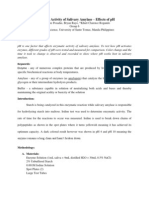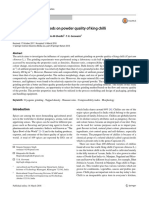Enzymes
Enzymes
Uploaded by
Shenelle BiggzCopyright:
Available Formats
Enzymes
Enzymes
Uploaded by
Shenelle BiggzOriginal Description:
Original Title
Copyright
Available Formats
Share this document
Did you find this document useful?
Is this content inappropriate?
Copyright:
Available Formats
Enzymes
Enzymes
Uploaded by
Shenelle BiggzCopyright:
Available Formats
NAMES: Patrice Burrows, Eddlytany Donne, Karla Hinshelwood, Shenelle Biggs CLASS: BIO 301, 1700 DUE DATES
& TIME: January 30, 2014 @ 3:00 p.m
TITLE: The Examination of Bromelian Activity in Gelatin Under different Conditions OBJECTIVES: The purpose of this experiment was to determine if fresh or canned pineapple juice affects the formation of gelatin and if pH or temperature had an effect on enzyme activity. HYPOTHESIS: If fresh pineapple juice is added to the gelatin then it will take longer for the gelatin to form compared to the canned pineapple juice because it contain bromelian that break down gelatin proteins preventing the gelatin from forming. If fresh pineapple juice is heated then gelatin will form because temperature is going to denature the bromelian in the pineapple juice. If bromelian is exposed to different pHs then gelatin formation will be slower because pH wont prevent the enzymes from breaking down the gelatin formation. INTRODUCTION: Enzymes are biological catalyst that increases the rate of chemical reactions taking place within living cells without themselves being changed. The reactant of an enzymes-catalyzed reaction is the as a substrate (Palmer, 2001).The substrates are converted into different molecules known as products at the end of the chemical reaction. Enzymes work by lowering the activation energy of the reaction thus the rate of the reaction increases. As a result, products are formed faster. Enzymes are substrate specific, which results from the enzymes unique three dimensional shape (Understanding How Enzymes Work, p. 111). Enzymes are normally facilitated by other factors. Cofactors are normally non-organic metal that aid in the action of enzymes. Enzyme cofactors are molecules that work by altering the shape of an enzyme so as to make it participate effectively during an enzymatic reaction (Fox, 2011). Most enzymes within the body have optimal conditions at which they perform their work. The major proteinase present in pineapple is Bromelian. Bromelian breaks down proteins to their amino acid by hydrolysis (Understanding How Enzymes Work, p. 112). Gelatin is a
protein known to be obtained from collagen (Understanding How Enzymes Work, p. 112). This laboratory examined the effect pineapple has on gelatin formation and the effect of pH and temperature on enzyme activity. MATERIALS AND METHODS: Bromelian and Gelatin When testing for the effect of bromelian on the formation of gelatin, a beaker was half filled with water and placed on a hot plate before the actual experiment. An ice bath was prepared and recorded to about 37 F. After the water began to boil the temperature was decreased and two packs of gelatin are added. The solution is left on hot plate to stay warm. Next three test tubes were placed on a tube rack. Three ml of the warm gelatin was added to the three test tubes. The tubes were labeled water, fresh, and canned accordingly. Using separate syringes two ml of each substance was added to the correct tube; water in the water tube, fresh pineapple juice in the fresh tube, and canned pineapple juice in the canned tube. That step was rapidly done mixed, and placed in iced water. The water test tube was observed carefully due to the fact that it should solidify between five and ten minutes. After all three solidified it was observed and recorded. Bromelian and Temperature When testing for the effect of temperature on the rate of bromelian activity, a beaker filled half way was prepared at 70 F. Three test tubes were placed on a tube rack labeled water, cold, and hot. Two ml of water was added to the water test tube, 2ml of fresh pineapple juice added to the test tube labeled cold and hot. Next, test tubes labeled water and cold are left in room temperature. The test tube labeled hot was placed into the 70F water bath for five minutes. After time the tube was removed and 3ml of warm gelatin was added. All three test tubes where placed in the ice bath. They were taken out as soon as the tube containing water and gelatin had solidified. The tubes were than observed and recorded. Bromelian and pH When testing for the effect of pH on the rate of bromelian activity, six test tubes were placed on a test rack. In tube 1 it contained 2 ml of water, tube 2 contained 2 ml of fresh pineapple juice, tube 3 contained 1 ml of HCL and 1 ml of fresh pineapple juice, tube 4 contained 1 ml HCL and
1 ml of water, tube 5 contained 1 ml NaOH and 1 ml ml of fresh pineapple juice, and tube 6 contained 1 ml NaOH and 1 ml of water. As the substance was being poured in the test the tubes were labeled with what it contained a number to avoid any confusion. Every tube was then mixed carefully, swirling the substances, these sat for three minutes, after time 3 ml of gelatin was added to each tube. All 6 tubes were then placed in the ice bath and taken out when tube number one containing water and gelatin solidified. Each tube was observed then recorded. RESULTS: The experiment was done to determine how bromelian works. Bromelian was used to see how enzymes affected the formation of gelatin. In the first experiment, the results were water and canned pineapple juice were solidified and fresh pineapple juice was liquefied after being in the ice bath for five to ten minutes. Furthermore, in the second experiment the results were that hot and cold water were both liquefied and water became solid. In the third experiment, after testing and examining how pH would affect the production of bromelian reaction, the results was that water, HCl mixed with water, NaOH mixed with fresh pineapple juice were all solidified while fresh pineapple juice and NaOH mixed with water were both solidified with a little liquid being poured out at the top. Leaving HCl mixed with fresh pineapple juice as a liquid.
Table: 1 The Effect of Bromelian on the Formation of Jello TEST TUBE Water Fresh pineapple juice Canned pineapple juice RESULT Solidified Liquefied Liquefied
Table: 2 The Effect of Temperature on the Rate of Bromelian TEST TUBE Water Cold water Hot water RESULTS Solidified Liquefied Liquefied
Table: 3 The Effect of pH on the Rate of Bromelian TEST TUBE Water Fresh pineapple juice HCl and Fresh Pineapple Juice HCl and Water NaOH and Fresh Pineapple Juice NaOH and Water RESULT Solidified Solidified with liquid on top Liquefied Solidified Solidified Solidified with little liquid on top
DISCUSSION: In this experiment, many tests were examined to find out how the enzyme bromelian works. Boromelian is an enzyme that occurs in pineapples including the leaves and stem (Understanding How Enzymes Work, 112). The purpose of this lab was to examine how enzymes work, using bromelian and gelatin as the substrate. Temperature and pH were two factors examined to see how they affected enzyme activity. In the first experiment, water, fresh pineapple juice and canned pineapple juice were examined to see the effect it had on gelatin formation. The water and canned pineapple juice solidified quicker than the fresh pineapple juice. The water and canned pineapple juice solidified
faster because there were no enzymes present in water and in the canned pineapple juice the enzymes denatured. On the other hand, fresh pineapple juice had the bromelian enzyme which was still functional to break down the gelatin protein preventing the gelatin formation from happening (Understanding How Enzymes Work, 112). In the second experiment, water, cold water, and hot water were examined to see the effect of temperature on the rate of bromelian activity. Gelatin was added to three test tubes to see which substance would solidify the fastest. Cold water and hot water was still a liquid while water became a solid. The water solidified faster than the cold and hot water because no enzymes inside of it to prevent it from forming a gelatin formation. This shows that temperature has no effect on gelatin formation in a substance because the cold and hot water was still a liquid when gelatin was added to the test tubes. In the last experiment, five substances were examined to see the effect of pH on the rate of boromelian. Water, a mixture of HCl and water, a mixture of NaOH and fresh pineapple juice, and NaOH and water solidified faster than the fresh pineapple juice, and a mixture of HCl and pineapple juice.An acid or a base shouldnt have affected the formation of gelatin because there were no bonds being broken in the gelatin. As you can see when an acid is mixed with the gelatin, no bonds are being broken and it is easy for the gelatin setting to appear. The results were incorrect for the NaOH and fresh pineapple juice because it shouldnt have solidified. The test tube was probably left in the ice to long. REFERENCES: Fox, S. (2011). In S. Fox, Human Physiology (p. 92). New York: The Mgraw Hill Publishers. Palmer, T. (2001). An Introduction to enzymes. In T. Palmer, Enzymes: Biochemistry, Biotechnology and Clinical Chemistry (p. 3). England: Horwood Publishing Limited. (n.d.). Understanding How Enzymes Work. In Exploring Biology in The Laboratory (pp. 111112).
You might also like
- Lab Report OsmosisDocument9 pagesLab Report OsmosisAsi Bts68% (19)
- CAPE Sociology May June 11 Unit 1 P1Document7 pagesCAPE Sociology May June 11 Unit 1 P1Shenelle Biggz75% (20)
- Enzyme Catalase Lab ReportDocument2 pagesEnzyme Catalase Lab ReportRizziel Nemes50% (2)
- Determination of Enzymatic Activity of Salivary Amylase Depending On The Effect of Temperature and PHDocument11 pagesDetermination of Enzymatic Activity of Salivary Amylase Depending On The Effect of Temperature and PHAmberValentineNo ratings yet
- Abstract:: Title: Bromelain As An EnzymeDocument5 pagesAbstract:: Title: Bromelain As An EnzymeArianne Jans MunarNo ratings yet
- Activity 2Document4 pagesActivity 2german guazaNo ratings yet
- CHEMISTRY ProjectDocument17 pagesCHEMISTRY ProjectMerin MariamNo ratings yet
- Denise Petite Anne A. Siojo September 10, 2013Document3 pagesDenise Petite Anne A. Siojo September 10, 2013Denise SiojoNo ratings yet
- Factors Affecting Enzyme Activity EssayDocument7 pagesFactors Affecting Enzyme Activity Essaylakshithasridhar2010No ratings yet
- Exp 6 Formal Lab Report 113BDocument14 pagesExp 6 Formal Lab Report 113BAlaina Weinheimer100% (3)
- Enzymes Lab ReportDocument7 pagesEnzymes Lab ReportMemorie BrownNo ratings yet
- LabReport20 01Document9 pagesLabReport20 01Hania SwachaNo ratings yet
- This Study Resource Was: Bromelain As An EnzymeDocument7 pagesThis Study Resource Was: Bromelain As An Enzymeapril hortilanoNo ratings yet
- Blue and White Doodle Science Project Cover A4 Document.pdfDocument14 pagesBlue and White Doodle Science Project Cover A4 Document.pdfsoumyaprksh16No ratings yet
- EnzymesDocument6 pagesEnzymesBenedique Valdez0% (1)
- Enzymes Lab Report - Activty 8Document6 pagesEnzymes Lab Report - Activty 8JengNo ratings yet
- Enzymatic Activity of Salivary Amylase Formal ReportDocument7 pagesEnzymatic Activity of Salivary Amylase Formal ReportKatrina Lee Gagan100% (2)
- Enzymes LolsDocument39 pagesEnzymes LolsA FloraldeNo ratings yet
- Experiment 7Document7 pagesExperiment 7kimber_gado100% (2)
- Enzymes LolsDocument38 pagesEnzymes LolsThon JustineNo ratings yet
- Why Does The Sugar Dissolve Slowly in Cold WaterDocument2 pagesWhy Does The Sugar Dissolve Slowly in Cold WaterDenn Kelly PengsonNo ratings yet
- Narrative ReportDocument6 pagesNarrative ReportNicole SaldivarNo ratings yet
- Ezyme and Its Activity - Lab ReportDocument17 pagesEzyme and Its Activity - Lab ReportRibka Kristania HadhiwaluyoNo ratings yet
- Chem Final - PrajithDocument13 pagesChem Final - PrajithA PRAJITH ARWESMENTNo ratings yet
- Prac ReportDocument3 pagesPrac ReportToga BrandonNo ratings yet
- Prac ReportDocument3 pagesPrac ReporttomsaikssNo ratings yet
- Chem12th Imp Proj PDFDocument8 pagesChem12th Imp Proj PDFKreya ParmarNo ratings yet
- Enzymes 2222222Document5 pagesEnzymes 2222222Anne KaoNo ratings yet
- Enyzmatic Activity of Salivary AmylaseDocument6 pagesEnyzmatic Activity of Salivary AmylaseGio Punsalan50% (2)
- Biology Implementation LabDocument4 pagesBiology Implementation Labsabrinacampbell1No ratings yet
- 3b Post LabDocument1 page3b Post LabIsabella CariagaNo ratings yet
- Liver Enzyme Lab Bio g10 2Document2 pagesLiver Enzyme Lab Bio g10 2api-462851756No ratings yet
- ChemDocument25 pagesChempanthergifNo ratings yet
- Lab 12 Pineapple and GelatinDocument3 pagesLab 12 Pineapple and GelatinKaleah SandyNo ratings yet
- Experiment 3 Lab ReportDocument10 pagesExperiment 3 Lab ReportVanessa Denise AguilarNo ratings yet
- Enzymes Lab ReportDocument13 pagesEnzymes Lab ReportIsland VitalNo ratings yet
- Harsh ChemistryDocument8 pagesHarsh Chemistryhateu1588No ratings yet
- rithanyaa B chem projectDocument5 pagesrithanyaa B chem projectdocumentsfile2024No ratings yet
- PineappleenzymelabDocument5 pagesPineappleenzymelabapi-233777623No ratings yet
- IA Bio Report EnzymesDocument11 pagesIA Bio Report EnzymesSofya SolntsevaNo ratings yet
- Enzymes Activity 9 I. PURPOSE: To Be Able To Describe The Effect of Temperature To The Action OffDocument3 pagesEnzymes Activity 9 I. PURPOSE: To Be Able To Describe The Effect of Temperature To The Action OffJovan Paul DeldaNo ratings yet
- Chemistry Investigatory Project Class 12Document6 pagesChemistry Investigatory Project Class 12adhyyansingh458No ratings yet
- Enzymatic Activity of Salivary AmylaseDocument4 pagesEnzymatic Activity of Salivary AmylaseKhurt RogandoNo ratings yet
- Isolation of ProteinDocument3 pagesIsolation of ProteinReysa Gabrielle PileNo ratings yet
- jBvNdGgbK7Document5 pagesjBvNdGgbK7akkuy975No ratings yet
- Alexa Riley - Enzyme Lab ExperimentDocument9 pagesAlexa Riley - Enzyme Lab Experimentapi-553676905No ratings yet
- Observing Enzyme Catalysis and Measuring Rate of Reactions: Lab ReportDocument16 pagesObserving Enzyme Catalysis and Measuring Rate of Reactions: Lab ReportArjun NaikNo ratings yet
- Chemistry ProjectDocument19 pagesChemistry ProjectKabeer Golechha100% (1)
- The Effects of PH and Temperature On The Enzymatic Activity of Salivary AmylaseDocument9 pagesThe Effects of PH and Temperature On The Enzymatic Activity of Salivary AmylaseMoira Mochie C. BasilioNo ratings yet
- Observing Enzyme Catalysis and Measuring Rate ofDocument16 pagesObserving Enzyme Catalysis and Measuring Rate ofGabrielNo ratings yet
- Harsh Singh Chemistry3Document10 pagesHarsh Singh Chemistry3hateu1588No ratings yet
- Chemistry Project Report OnDocument9 pagesChemistry Project Report OnVarun Jain67% (3)
- AFL 2 10th - Enzymes LaboratoryDocument3 pagesAFL 2 10th - Enzymes LaboratoryCAMILO GUZMAN DORADONo ratings yet
- Biochem Expt 6Document5 pagesBiochem Expt 6SEAN JODI M. COSEPENo ratings yet
- An Experiment Investgating Temperature On EnzymesDocument3 pagesAn Experiment Investgating Temperature On EnzymesShoumit SarkarNo ratings yet
- Chemistry Investigatory Project - BS12B205Document20 pagesChemistry Investigatory Project - BS12B205msarathikavyaNo ratings yet
- Lingesh CHEDocument10 pagesLingesh CHEvendhankeerthiNo ratings yet
- Chemistry Investigatory Project (1) 3Document16 pagesChemistry Investigatory Project (1) 3Manjushree .TNo ratings yet
- On Digestive Proteolysis: Being the Cartwright Lectures for 1894From EverandOn Digestive Proteolysis: Being the Cartwright Lectures for 1894No ratings yet
- Fruit Infused Water: 100 Delicious And Healthy Fruit Infused Water Recipes (Vitamin Water, Detox Diet, Better Sleep, Weight Loss, Liver Cleanse and Metabolism Boosting)From EverandFruit Infused Water: 100 Delicious And Healthy Fruit Infused Water Recipes (Vitamin Water, Detox Diet, Better Sleep, Weight Loss, Liver Cleanse and Metabolism Boosting)No ratings yet
- Introduction: Themes in The Study of Life: For Campbell Biology, Ninth EditionDocument159 pagesIntroduction: Themes in The Study of Life: For Campbell Biology, Ninth EditionShenelle BiggzNo ratings yet
- Introduction: Themes in The Study of Life: For Campbell Biology, Ninth EditionDocument159 pagesIntroduction: Themes in The Study of Life: For Campbell Biology, Ninth EditionShenelle BiggzNo ratings yet
- ReflexesDocument6 pagesReflexesShenelle BiggzNo ratings yet
- Assignment#01Document5 pagesAssignment#01mishkatk417No ratings yet
- Convective Heat and Mass Transfer in Porous Media 1991Document1,083 pagesConvective Heat and Mass Transfer in Porous Media 19917dnp2yypcgNo ratings yet
- FG Wilson P13.5-4Document4 pagesFG Wilson P13.5-4عبدالحميد عبدالغفار الدرديريNo ratings yet
- 3RH - Contactor RelaysDocument13 pages3RH - Contactor Relaysreza_powerNo ratings yet
- SKF Insocoat 2017 BrochureDocument5 pagesSKF Insocoat 2017 BrochureHector MaldonadoNo ratings yet
- 코딩 교육 프로그램 엔트리를 활용한 어린이 중국어 학습자료 개발Document182 pages코딩 교육 프로그램 엔트리를 활용한 어린이 중국어 학습자료 개발taehyung kimNo ratings yet
- Gravity Sewer Line Bypass: Flow and Pump Sizing Chart Line Size % Full Velocity Flow (MGD) Flow (GPM) Pump Size Godwin PumpDocument2 pagesGravity Sewer Line Bypass: Flow and Pump Sizing Chart Line Size % Full Velocity Flow (MGD) Flow (GPM) Pump Size Godwin PumpMohamed Badian TraoreNo ratings yet
- Welding Procedure Specification: Wps No.: Bpscl/Shel/Wps - 05 DateDocument2 pagesWelding Procedure Specification: Wps No.: Bpscl/Shel/Wps - 05 DateAmjad Pathan100% (1)
- Data Analyst Resume SampleDocument2 pagesData Analyst Resume SampleADS TEAMNo ratings yet
- Routh-Hurwitz CriteriaDocument7 pagesRouth-Hurwitz CriteriaRevathi KrishnanNo ratings yet
- Vijay SCOTCH YOKE MECHANISM DOUBLE ACTING HACKSAWDocument31 pagesVijay SCOTCH YOKE MECHANISM DOUBLE ACTING HACKSAWSergio PugazhNo ratings yet
- Arduino Micro Controller Processing For EveryoneDocument114 pagesArduino Micro Controller Processing For Everyonemayurdangi69No ratings yet
- Oracle Patch Update 12.2.1.4Document11 pagesOracle Patch Update 12.2.1.4Siddu BalaganurNo ratings yet
- Computer Architecture Quick NotesDocument2 pagesComputer Architecture Quick NotesAgrippa MungaziNo ratings yet
- Understanding Vector Group of Transformer: Primary WindingsDocument10 pagesUnderstanding Vector Group of Transformer: Primary Windingsbala muruganNo ratings yet
- Effect of Grinding Methods On Powder Quality of King Chilli: Singam Suranjoy Singh Bhupendra M Ghodki T. K. GoswamiDocument9 pagesEffect of Grinding Methods On Powder Quality of King Chilli: Singam Suranjoy Singh Bhupendra M Ghodki T. K. GoswamiAnonymous fG9C1xxooQNo ratings yet
- 14-05-23 JR - Super60 (Incoming) NUCLEUS BT Jee-Adv (2020-P2) WTA-02 Key & Sol'sDocument10 pages14-05-23 JR - Super60 (Incoming) NUCLEUS BT Jee-Adv (2020-P2) WTA-02 Key & Sol'sbhavanashiva69No ratings yet
- SSAB Machining Strenx 2017Document28 pagesSSAB Machining Strenx 2017RogerNo ratings yet
- EL ManualDocument38 pagesEL Manualcommando.blacklightNo ratings yet
- Fieldbus ActuatorsDocument12 pagesFieldbus Actuatorsvsswami_82No ratings yet
- Measuring Elements in Water by Flame Atomic Absorption SpectrophotometryDocument6 pagesMeasuring Elements in Water by Flame Atomic Absorption SpectrophotometryAamir NaweedNo ratings yet
- CHE 402 - CamachoRC - 02Document3 pagesCHE 402 - CamachoRC - 02RichCamachoNo ratings yet
- Semi-Detailed LP - PolynomialsDocument3 pagesSemi-Detailed LP - PolynomialsJohn Paul MirandaNo ratings yet
- Eductor SystemDocument8 pagesEductor Systemapi-219509070No ratings yet
- Nano Bubble Product CatalogueDocument21 pagesNano Bubble Product Cataloguewijaya adidarmaNo ratings yet
- PLC Basic Exercises For SiemensDocument3 pagesPLC Basic Exercises For SiemensMudassar Mustafa100% (1)
- CR-2000 DS-8690Document2 pagesCR-2000 DS-8690Juan JuanNo ratings yet
- Micropump 380manualDocument20 pagesMicropump 380manualمحمود سلحشورNo ratings yet
- AP Physics C Electricity Study GuideDocument25 pagesAP Physics C Electricity Study GuideLama DiriyehNo ratings yet
- Answers To End-Of-Chapter Questions: A I II III BDocument1 pageAnswers To End-Of-Chapter Questions: A I II III BMeera BaiNo ratings yet




























































































